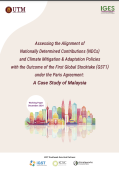This report calculates the natural capital value of forests in Canada by means of the defensive expenditures approach. It includes two main parts: (i) general background on Canada’s forests and approaches to natural capital valuation, and (ii) case studies for each of Canada's eight forest regions. Each study provides an introduction to the forest region and explores the natural capital value of at least one conserved forest property.
Monetary valuation of the benefits uses the latest Environment and Climate Change Canada values of the Social Cost of Carbon. Reflecting the diversity of forest types, densities, and geographic features, a relatively broad range of natural capital values were calculated. The case study properties provide services valued at between $5,800 to $46,000 per hectare per year in natural capital benefits, with an average benefit of $26,382 per hectare per year. The specific valuation depends on the type of forest and where it is located. For example, the ecological services of the maple-dominated forests in the Great Lakes–St. Lawrence forest region of Quebec are valued at approximately $20,000 per hectare; the lowland boreal forests in eastern Manitoba have an annual value of $26,800 per hectare, demonstrating the importance of peatlands in storing and holding carbon; and the big trees of British Columbia’s coastal forest region provide more than $33,000 per hectare.


